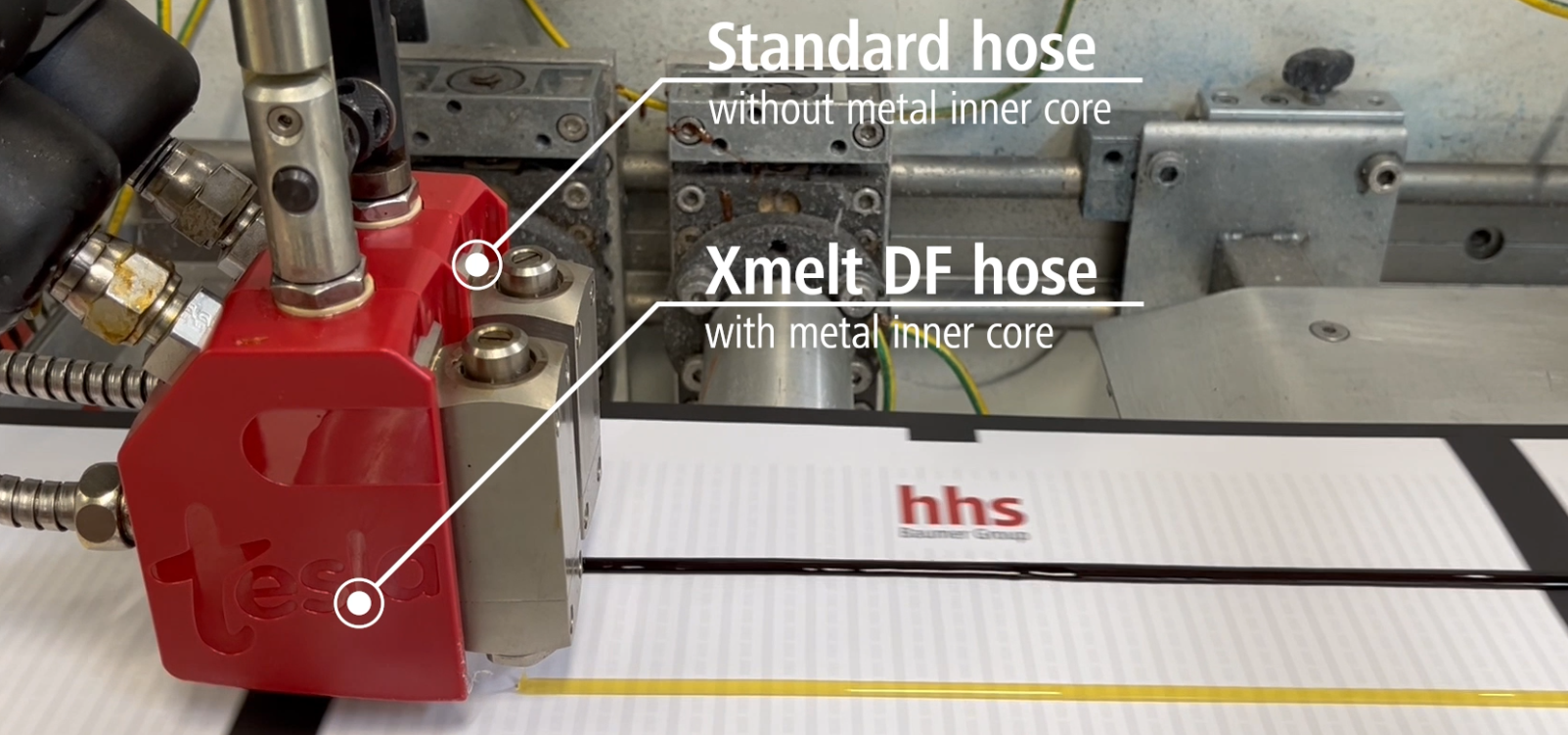Xmelt DF hotmelt hoses are designed to minimize the negative impacts of adhesive degradation, including issues such as charring, premature curing, discoloration, and unpleasant odors. They ensure trouble-free production and higher system availability
Hot melt systems, despite the continuous flow of hot melts, are prone to charring. This happens when even the smallest remnants of hot melt accumulate in tiny spaces and burn, forming hard, dark lumps that clog filters and nozzles. Over time and unavoidable, hot melt residue builds up on the inner walls of the existing hotmelt hoses, causing further charring. This buildup can cause blockages, leading to packaging process failures and disruptions to upstream processes. Consequently, the components of the hot melt system may need to be flushed and prematurely replaced due to charring. Taking proactive measures is essential to prevent disruptions and reduce waste for sustainable and profitable production.
Unveiling the Crucial Role of Hot Melt Hoses in Preventing Charring
Hot melt adhesives rely on the presence of oxygen to undergo a charring process when utilized with hotmelt equipment at typical operating temperatures. The synergy between heat and oxygen accelerates the formation of char, potentially leading to complications in adhesive applications. To mitigate charring, two approaches can be employed: reducing the adhesive temperature and minimizing or eliminating exposure to oxygen.
The engineers at Baumer hhs have discovered the causes of charring in hotmelt hoses. They conducted an experiment where they heated multiple hot melt hoses with different designs to simulate burns. When the adhesive was released from the hoses, it became clear that the adhesive in the metal connections did not show any signs of burning, while clear signs of burning were observed in the flexible hose, indicated by different discolorations. The lack of charring in the connection area can be attributed to the metal being gas-tight, as the temperature of the connections is equal or higher. Conversely, charring occurred in the plastic hose area, indicating that these are not gas-tight.
The findings from the research show that as temperatures increase, the ability of oxygen to pass through thermoplastic tubing grows significantly. Even materials like silicone or PTFE, which are relatively resistant to permeation at room temperature, become noticeably more permeable at higher temperatures. This finding is significant because it demonstrates that when a small amount of hot melt contacts the expansive inner area of the thermoplastic tubing, it enhances the transmission of oxygen due to the increased surface area. the transmission of oxygen.
After realizing how important it is to minimize exposure to oxygen, we worked closely with our development partners to tackle this challenge. Our investigation led us to the gas industry, where we found that gas hoses, which need to be both airtight and flexible, could be a suitable solution. After thoroughly researching patents and literature, we discovered that using a hot melt hose with a flexible metal core for transportation was not a new idea, but it seemed to be the most effective option available at the time.
Xmelt DF hoses prevents charring of the hot melt adhesive, maintaining stability for 50 hours without flow.
The positive impact of Xmelt DF hoses was assessed by comparing a standard hose with a PTFE inner core to an Xmelt DF hose. Both hoses were continuously heated for 50 hours at a temperature of 180°C. The results were noteworthy: the adhesive from the Xmelt DF hose remained absolutely clear and unchanged, while the adhesive from the standard hose showed strong signs of burning and discoloration. This resulted in nozzle and filter blockages during production.
The abbreviation DF stands for ‘degradation free’, a claim supported by extensive testing. Xmelt DF hoses effectively avoids burning, ensuring trouble-free production and higher system availability.
Xmelt DF Hoses: Reducing Spare Parts and Improving Energy Usage
The Xmelt DF hoses offer several additional benefits worth considering. Components such as nozzles, filters, and hot melt hoses often require frequent replacement due to blockages and deposits. However, these issues can be minimized by utilizing Xmelt DF hoses. Furthermore, the Xmelt DF hose is now equipped with a durable, enclosed covering that is highly resistant to abrasion and completely waterproof on its outer surface. It is expected that the Xmelt DF hoses will have double the lifespan of traditional hoses. Surprisingly, we found that the energy consumption of Xmelt DF hoses is approximately 20% lower due to the superior heat transfer of the metal inner tubes compared to PTFE or silicone inner tubes.
Baumer hhs encountered a significant obstacle when a competitor filed a patent for a flexible hot melt hose featuring a metal inner core. This hindered the company's development efforts for several years. In response, Baumer hhs, along with two other industry partners, took proactive measures to oppose the patent claimed by their competitor. Their efforts culminated in the complete revocation of the patent by the European Opposition Division on May 8th, 2024. The patent holder has filed an appeal against the decision, so the initial decision in the patent opposition proceedings is not legally binding at the moment. We are confident that the existing prior art, which also covers the solution provided by Baumer hhs, will allow us to continue marketing the Baumer hhs Xmelt DF hot melt hoses both now and in the future.
The Xmelt DF hoses are now available for Baumer hhs systems and competitor systems equipped with Ni-120 RTD. Take advantage of our limited-time introductory discount of 50% until July 15, 2024. Reach out to us to claim your personalized offer today.

